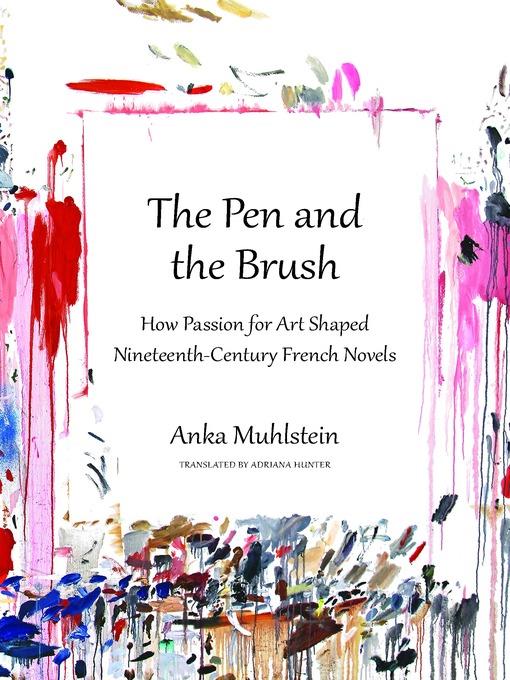
The Pen and the Brush
How Passion for Art Shaped Nineteenth-Century French Novels
کتاب های مرتبط
- اطلاعات
- نقد و بررسی
- دیدگاه کاربران
نقد و بررسی

September 19, 2016
With personable prose and erudition, Muhlstein (Monsieur Proust’s Library) reveals seemingly all there is to know about the relationship between 19th-century French novels and painting. She cites the Louvre’s open access policy, spurred by the French Revolution, and art’s robust presence in French life as influences on the emergence of “the visual novel.” The authors covered in this rich and detailed analysis include Honoré de Balzac,
Joris-Karl Huysmans, Guy de Maupassant, Marcel Proust, and Émile Zola. While discussing their work, Muhlstein forms a new lexicon of literary devices used in the 19th-century French novel. She refers to Zola as the first “landscapist writer” because he drew from the Impressionists’ use of light, and regards Proust’s use of works of art to describe character traits as creating “pictorial allusions.” Muhlstein shows how specific paintings—Edouard Manet’s “Olympia” or Giotto’s “Idolatry”—served as a foundation for visual descriptions or moved plot forward. She also explores the personal lives of the writers, adding fun tidbits about Zola’s career as an art critic and friendship with Paul Cézanne. Muhlstein’s extensive knowledge of art and literature make for a fascinating, instructive, and absorbing read.

October 15, 2016
How hundreds of stolen paintings affected 19th-century French writers.Goncourt Prize-winning author Muhlstein approaches literature in a unique way. In Monsieur Proust's Library (2012), she explored his lengthy novel via the books he read, while Balzac's Omelette (2011) examined how food influenced his novels. Here, Muhlstein looks at French authors of the 19th century via art, starting with the French Revolution. Thanks to Napoleon's victories and his "to the victor belong the spoils" approach, convoys laden with great art made their ways to France (especially the Louvre). The government then did something new, letting their citizens view the art for free. The public and writers went in droves. Thus, "two forms of art were entwined." Muhlstein focuses on the writings of Balzac, Zola, Huysmans, Maupassant, and Proust to show how they were profoundly affected by these works of art, many of which they had never seen before. Each began creating more artist characters and, more importantly, "truly invented a visual style of writing." Balzac came under the influence of Rembrandt, Raphael, and Delacroix. "Opening a Balzac novel," writes Muhlstein, is like walking into a museum," watching the artists and models "step out of their frames to come into the story." Unlike Balzac, Zola always lived among painters, and the influence of art on his writing style was immense. Cezanne was a good friend, and Zola often modeled for his paintings. Under the influence of the impressionists and their attention to light, Muhlstein argues, Zola "became the first landscapist writer." Huysmans' "extravagant and fantastical" novel Against the Grain clearly shows the influence of the painter Gustave Moreau. Maupassant chose to make a painter his main character in Strong as Death: "his characters' choice of art would inform readers about their personalities." The "last great fictional painter" of the century, Proust, was deeply affected by the works of Monet and Turner. An enlightening exploration of the symbiotic relationship between art and literature.
COPYRIGHT(2016) Kirkus Reviews, ALL RIGHTS RESERVED.

November 15, 2016
It's no secret that some of the prominent 19th-century French writers were fanatical about art and artists. Mulhstein (Balzac's Omelette) probes the connection between author and artist by focusing on five writers: Honore de Balzac, Emile Zola, Joris-Karl Huysmans, Guy de Maupassant, and Marcel Proust, to consider the roles of painters and paintings in each of their stories. Some of the authors used famous works to create imagery in their writing; others depicted the lives of fictional artists and how they interacted with the world. Most of the book focuses on Balzac, Zola, and Proust, touching on Huysmans and Maupassant briefly. This enables readers to get a comprehensive look at the relationship between writer and painter. These men not only penned novels about artists, they surrounded themselves with them. VERDICT Readers interested in the history of art and literature will enjoy this crossover. Examining how these authors interpreted the art world provides new insight into 19th-century French culture. --Rebecca Kluberdanz, New York P.L.
Copyright 2016 Library Journal, LLC Used with permission.

























دیدگاه کاربران